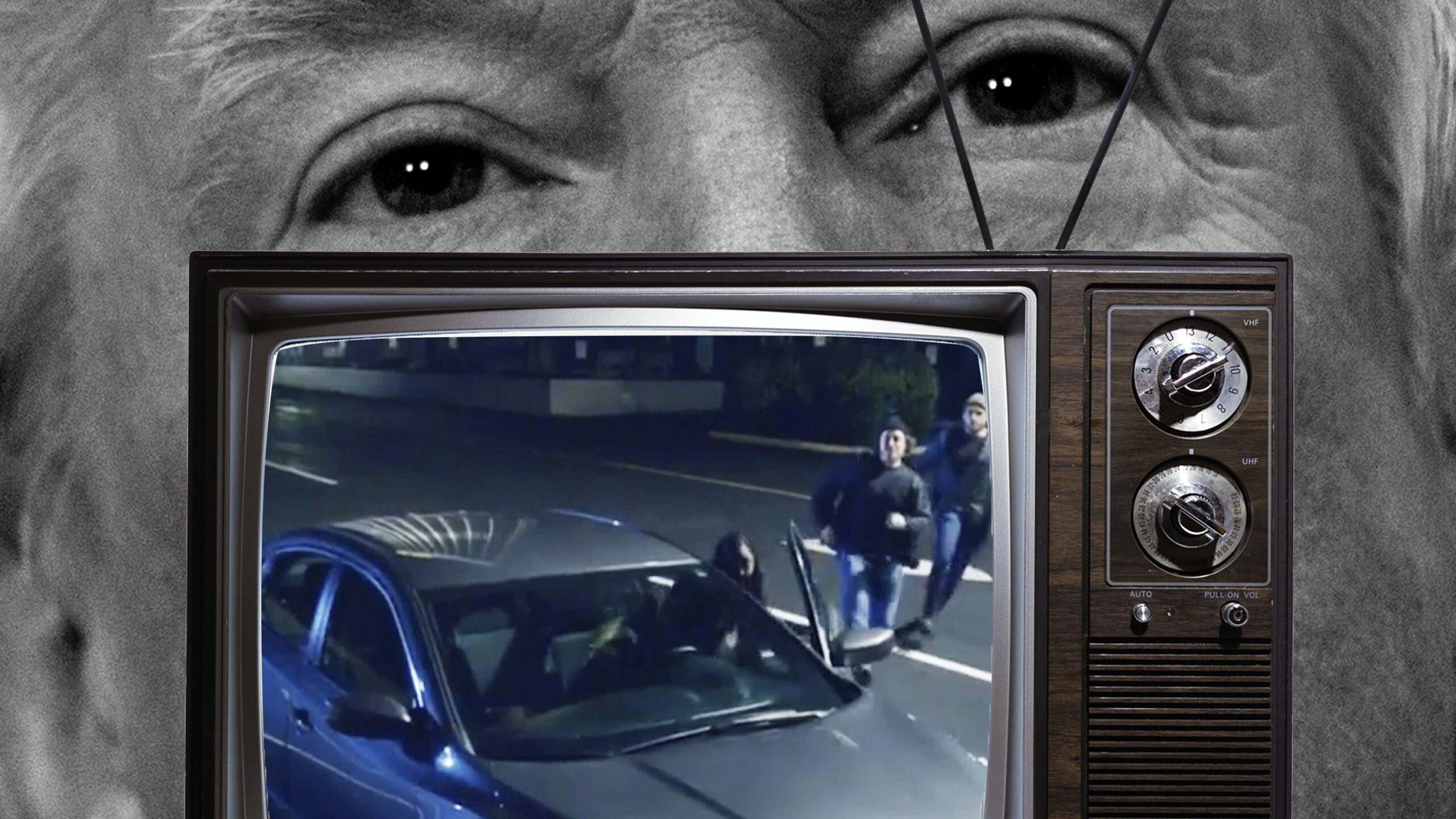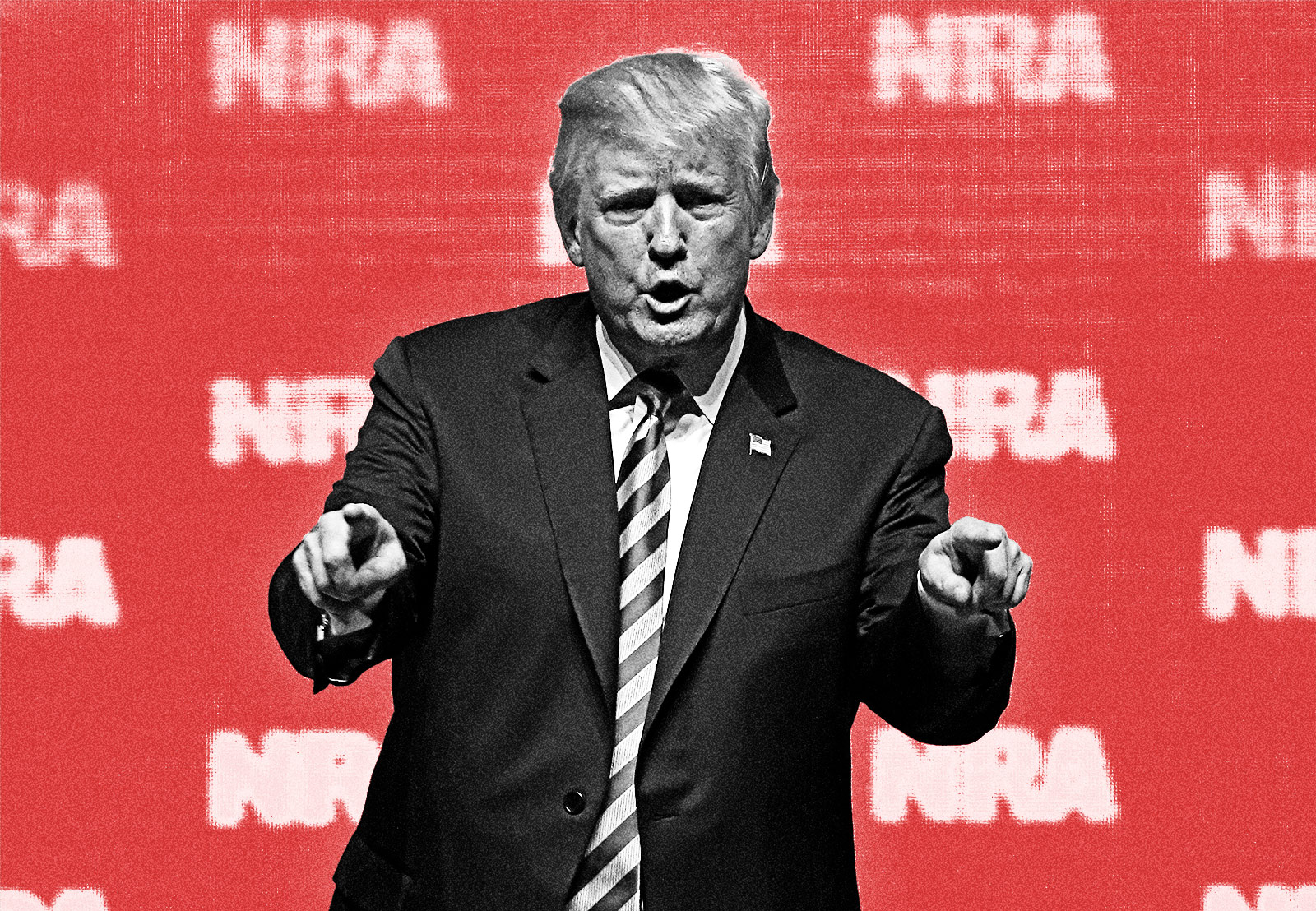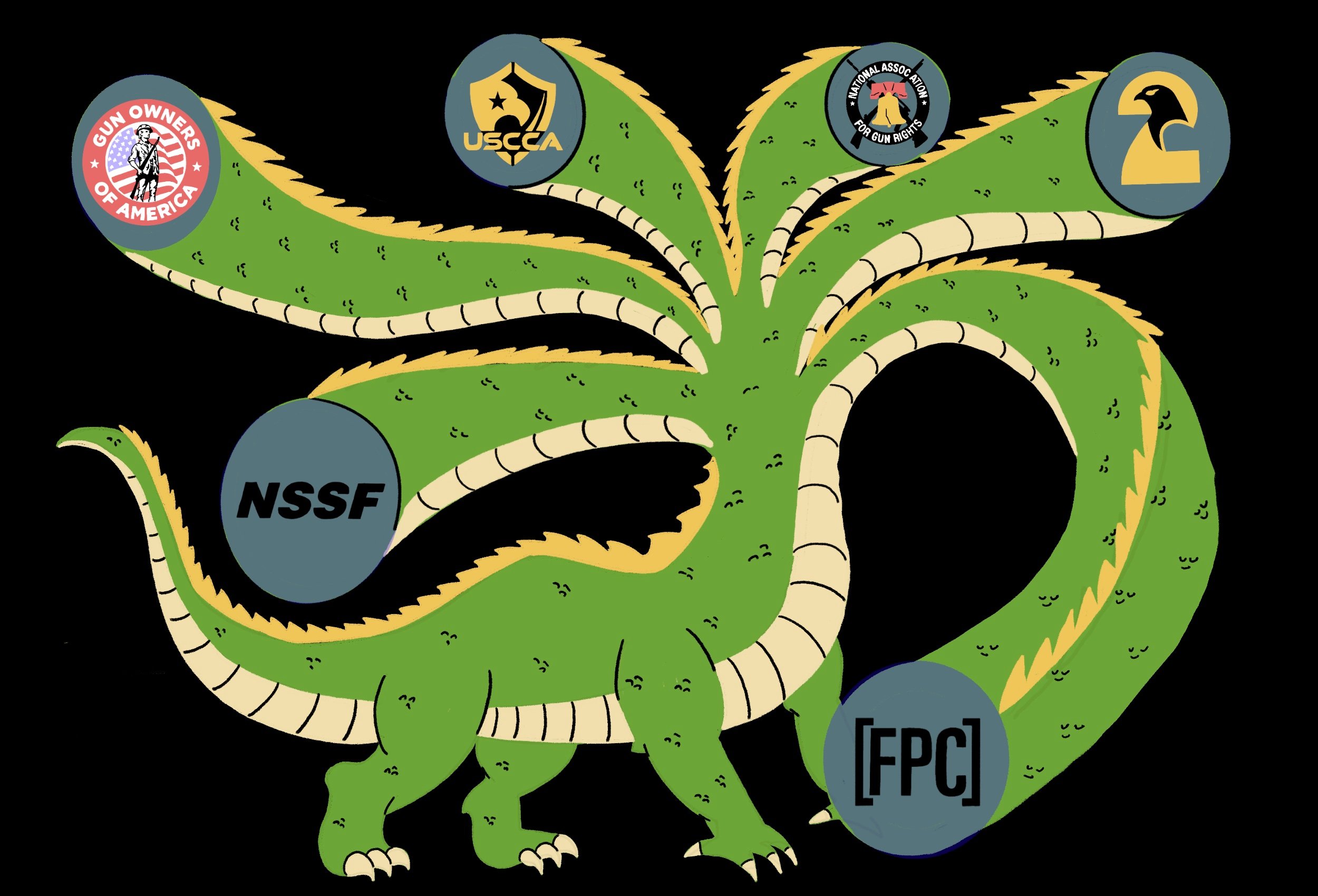In a recent ad bankrolled by the National Rifle Association, two masked men chase a woman through a parking lot to her gray sedan. She locks the doors and scrambles to grab her gun from the car’s console. A voiceover kicks in: “Joe Biden would take her rights away.” The gun dissolves into thin air, just as the driver’s side window shatters.
The ominous 30-second spot, called “Carjack,” aired more than 10,000 times in swing districts across Michigan, Pennsylvania, Arizona, North Carolina, and Wisconsin during a two-week period in late August and early September. The NRA paid more than $4.1 million for the ad to run during shows like Jimmy Kimmel Live! and The View.
During that time, re-election ads for President Donald Trump that had been playing as early as May effectively stopped. In some cases, the president’s ads — which became less frequent on all national airwaves during this period — started up again days after the NRA’s ad buy ended.
It’s probably not a coincidence. The NRA and the Trump campaign placed those ads through two companies that appear separate on paper, but reporting by The Trace indicates they are affiliates of National Media Research, Planning and Placement, an influential conservative firm in Alexandria, Virginia. We identified four National Media employees whose names or signatures also appear on recent documents related to the shell companies. In fact, the three firms are so closely linked that they share a phone number. Earlier reporting by The Trace showed that National Media was at the center of a similar ad-buying strategy in 2016.
Former high-ranking Federal Election Commission (FEC) members and government watchdogs told The Trace that the overlapping personnel, and the ads’ seemingly choreographed timing, suggest an arrangement that violates campaign finance laws. The FEC, which oversees political advertising, bars candidates’ campaigns from working in concert with independent groups — such as, in this case, the NRA. If these campaigns did in fact coordinate, millions of dollars in spending could count as in-kind contributions to the Trump campaign, and the firms could face civil fines and a possible criminal referral to the Justice Department.
The suspicious arrangement comes even as the NRA faces multiple legal battles and an unusual challenge to its nonprofit status from the attorney general of New York, Letitia James, who is seeking to dissolve the organization.
A former FEC Commissioner and a former general counsel to the FEC both told The Trace that there’s enough evidence to open an inquiry into whether the campaigns conspired to fix their media schedules — which could, in effect, reduce competition for ad time and keep prices artificially low.
However, it may be years before that happens, if it ever does.
“That is certainly enough to argue that it’s coordinated,” said Ann Ravel, a former FEC commissioner who is now a Democratic nominee for the California State Senate. “While the serial ad purchases may have been designed to hide any evidence of coordination,” she said, “it seems pretty obvious in the real world.”
National Media is a powerhouse in the business of political strategy, placing ads and analyzing demographics for prominent Republicans and the National Republican Senatorial Committee. It is also the parent of a group of affiliated shell companies.
Red Eagle Media, which buys ads for the NRA, is one of those affiliates, according to Virginia business records, which identify the business as an “assumed or fictitious name” of National Media. Another National Media-connected vendor, Harris Sikes Media, is buying ad time on behalf of Trump. Like the other shell companies, they appear at first glance to have no relation to National Media. But records show that Red Eagle and Harris Sikes share not only a phone number, but several staffers with National Media.
Red Eagle’s contracts are signed by Steve Syckes, an accountant at National Media, Federal Communications Commission (FCC) documents show. Harris Sikes’ business records filed in Virginia last year bear the signature of Robin D. Roberts, National Media’s current president. National Media’s CFO, Jonathan Ferrell, signed some of this year’s contracts for Trump campaign ads as an authorized representative for Harris Sikes. And Ben Angle — whom The Trace has previously linked with Red Eagle during the 2016 campaign — is listed as the contact for Harris Sikes.
What’s more, documents show that National Media is headquartered at 817 Slaters Lane in Alexandria, Virginia, while Red Eagle is located across a parking lot at 815 Slaters Lane. Paperwork filed by Harris Sikes lists both of those addresses, as well as the Fairfax, Virginia, address of a lawyer who has represented all three firms.
Political vendors like National Media are allowed to work on multiple campaigns, as long as strategies and data are kept siloed from other campaigns, especially those that could benefit. But spending patterns across the NRA- and Trump-affiliated firms, former FEC officials say, should get further scrutiny.
So far in the election cycle, at least 71 TV stations and 15 cable providers across five states have run ads for both the Trump campaign and the NRA, according to thousands of pages of FCC records. All told, the gun group has spent $9.7 million in federal races this election season, according to filings tracked by The Trace. That’s less than the $18.6 million the NRA spent during the same time period in 2016, but about five times more than it spent in 2012.
Most of the time, Trump ads placed by Harris Sikes didn’t air during the same period as the NRA-purchased ads, FCC documents show. In a few cases, they overlapped for a few days before the Trump ads stopped playing.
For instance, Harris Sikes spent $80,570 on 305 ads on behalf of the Trump campaign on WAOW, a Wisconsin ABC affiliate, between July 22 and August 21, according to FCC documents. But once “Carjack” — which was placed by Reg Eagle — started airing, Harris Sikes’ ads for the Trump campaign all but halted, with an uncharacteristically small purchase of four spots on the station the following week.
In another example, Red Eagle spent $33,950 for the “Carjack” ad to air 94 times on Flint, Michigan, ABC affiliate WJRT between August 21 and September 3, according to invoices filed with the FCC. Starting on September 8, Harris Sikes paid $429,065 for 1,394 ads supporting Trump’s re-election to appear on shows, including Good Morning America and Live with Kelly and Ryan on the same network.
“What you sometimes see in a coordination effort is not that they overlap in what they’re doing, but they do take different timeframes,” said Larry Noble, a former general counsel for the FEC. That sort of divide-and-conquer media strategy may allow political campaigns to save money.
Ravel, the former FEC commissioner, agreed that a serial strategy could benefit the linked campaigns. “It allows them to spread their resources further,” she said.
The Trump ads became infrequent during a period that included the Republican National Convention. The Associated Press reported that it is unusual for a candidate’s advertising to drop off during a convention, and a Trump spokesman told the outlet they were preparing to air more ads in the fall.
Calls and emails seeking comment for this story from National Media, Red Eagle, Harris Sikes, Jon Ferrell, Steve Syckes, Ben Angle, and Robin D. Roberts were not returned. The NRA and the Trump campaign also did not respond to requests for comment.
The patterns by the National Media affiliates this year appear to be only the latest version of a consistent strategy.
In 2018, The Trace reported that the NRA and the Trump campaign appeared to have coordinated ad campaigns during the 2016 election. It’s no secret that the gun group spent over $30 million in order to help elect Trump, amounting to the greatest campaign spending spree in its history. But the buying patterns suggested it had also maneuvered around campaign finance laws to boost the more direct, trackable political spending.
While National Media was at the center of the 2016 strategy, another company, American Media & Advocacy Group (AMAG), worked on behalf of the Trump campaign, FCC documents showed. Ferrell, the National Media CEO, signed contracts on behalf of affiliates working for both the NRA and Trump. These middlemen companies placed ads that played on the same stations during the same shows and were aimed at the same audience, according to thousands of pages of FEC and FCC documents reviewed by The Trace at the time.
Following The Trace’s reporting, the Campaign Legal Center and the Giffords Law Center sued the FEC to try to compel an investigation into the ad purchases. Last year, a judge denied the FEC’s attempts to have the suit dismissed on procedural grounds, and the suit is ongoing.
While the “Carjack” ad was commissioned by the NRA, and is arguably about gun rights, paperwork shows that the aim was to affect the presidential campaign. One filing shows that the ad buyer describes the political message of the spot as Biden “wants to cut police funding,” a false characterization of the Democratic nominee’s position. In another unsigned filing from August 20, the message is blunter: “It’s an anti-Biden spot from NRA.”
Federal campaign finance rules have undergone dramatic change since the 2010 Supreme Court decision in Citizens United v. FEC. That decision allowed political campaigns to spend unlimited sums of money, as long as they weren’t sharing data or coordinating their advertising. The law is meant to keep politicians from having to repay favors to deep-pocketed backers who coordinated with their campaigns. Otherwise, the ad spending could be seen as violating a $5,000 limit for donations, or as constituting in-kind contributions.
In practice, though, the FEC hardly regulates ad coordination. The FEC strongly suggests that companies have firewalls to prevent the illegal sharing of information — but it doesn’t require them, Noble said. And when there are concerns that a company without strict data protections has illegally shared information, the burden of proof is on the FEC. “This whole idea of setting firewalls just doesn’t work,” Noble added.
It’s unlikely the FEC would look into coordination claims any time soon. It has been gridlocked since July, when a commissioner stepped down and left the agency one member short of a quorum — a necessary hurdle to clear before any investigation could take place. Even if Congress approved a replacement, the bipartisan commission has often stalled when it comes to enforcing the law, and an ideological divide has widened in recent years about whether it even should.
For instance, former Republican FEC Commissioner Bradley A. Smith argued in an op-ed in The Wall Street Journal last month that more contributions should remain private, lest they become fodder for “cancel culture.” The agency took no action after The Trace unearthed evidence that the NRA coordinated with the Trump campaign in 2016. According to the commission’s own records, enforcement actions since 2010 have largely focused on violations around record keeping and timely disclosure.
“There’s obviously some real limitations on enforcement by the FEC,” said Noah Bookbinder, executive director at the Center for Responsibility and Ethics in Washington, a pro-transparency group that’s currently suing the FEC over campaign finance disclosures.
The FEC doesn’t have the power to press criminal charges, though it has made the rare criminal referral to the Justice Department, according to Ravel. “That’s one of the problems with the FEC: they make it so general, they make it so easy for the commissioners to not actually find coordination,” she said.
Of the apparent coordination between the NRA and the Trump campaign, Ravel said: “This is the kind of thing that just sort of screams corruption, doesn’t it?”


